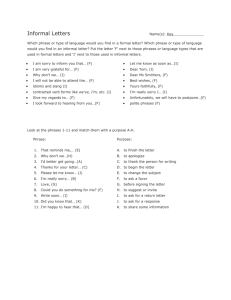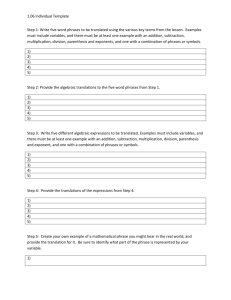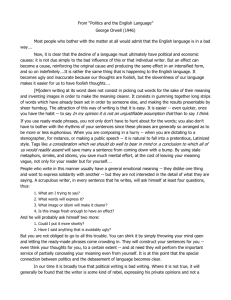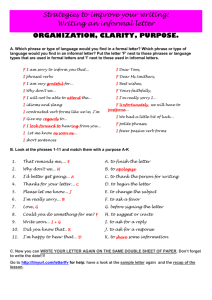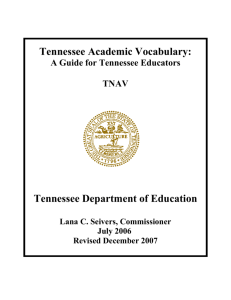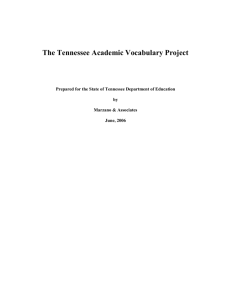Vocab intro 08
advertisement
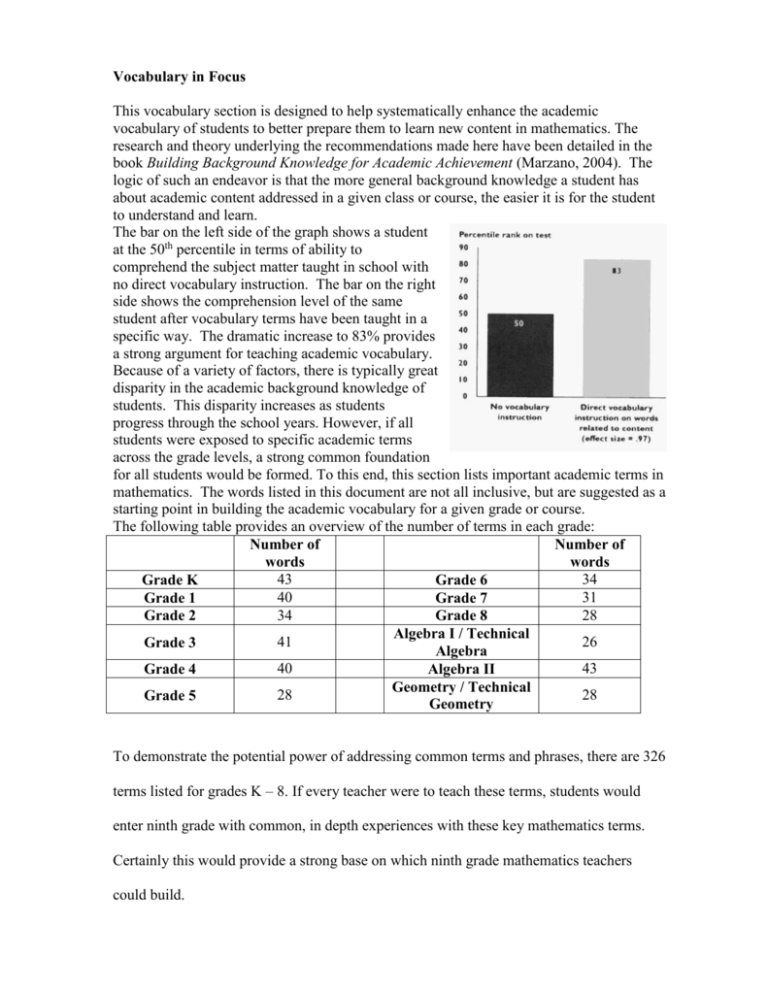
Vocabulary in Focus This vocabulary section is designed to help systematically enhance the academic vocabulary of students to better prepare them to learn new content in mathematics. The research and theory underlying the recommendations made here have been detailed in the book Building Background Knowledge for Academic Achievement (Marzano, 2004). The logic of such an endeavor is that the more general background knowledge a student has about academic content addressed in a given class or course, the easier it is for the student to understand and learn. The bar on the left side of the graph shows a student at the 50th percentile in terms of ability to comprehend the subject matter taught in school with no direct vocabulary instruction. The bar on the right side shows the comprehension level of the same student after vocabulary terms have been taught in a specific way. The dramatic increase to 83% provides a strong argument for teaching academic vocabulary. Because of a variety of factors, there is typically great disparity in the academic background knowledge of students. This disparity increases as students progress through the school years. However, if all students were exposed to specific academic terms across the grade levels, a strong common foundation for all students would be formed. To this end, this section lists important academic terms in mathematics. The words listed in this document are not all inclusive, but are suggested as a starting point in building the academic vocabulary for a given grade or course. The following table provides an overview of the number of terms in each grade: Number of Number of words words 43 34 Grade K Grade 6 40 31 Grade 1 Grade 7 34 28 Grade 2 Grade 8 Algebra I / Technical 41 26 Grade 3 Algebra 40 43 Grade 4 Algebra II Geometry / Technical 28 28 Grade 5 Geometry To demonstrate the potential power of addressing common terms and phrases, there are 326 terms listed for grades K – 8. If every teacher were to teach these terms, students would enter ninth grade with common, in depth experiences with these key mathematics terms. Certainly this would provide a strong base on which ninth grade mathematics teachers could build. A five-step process There is no single best way to teach terms and phrases. However, research and theory on vocabulary development point to a few generalizations that provide strong guidance. 1. Initially Provide Students with a Description, Explanation, or Example as Opposed to a Formal Definition When introducing a new term or phrase it is useful to avoid a formal definition at the start. Formal definitions are typically not very “learner friendly.” They make sense after there is a general understanding of a term. Provide students with a description, explanation, or example. Ask students what they already know to avoid misconceptions. 2. Have Students Generate Their Own Descriptions, Explanations, or Examples Once a description, explanation, or example has been provided to students, they should be asked to restate that information in their own words. It is important that students do not copy exactly what the teacher has offered. Student descriptions, explanations, and examples should be their own constructions using their own background knowledge and experiences to forge linkages between the new term or phrase and what they already know. 3. Have Students Represent Each Term or Phrase Using a Graphic Representation, Picture, or Pictograph Once students have generated their own description, explanation, or example they should be asked to represent the term or phrase in some graphic, picture, or pictographic form. This allows them a different, nonlinguistic way to process the information. It also provides a second processing of the information which should help deepen students’ understanding of the new term or phrase. 4. Have Students Keep an Academic Vocabulary Notebook Over time students will develop an understanding of a set of terms and phrases that are important to the academic content in mathematics. This implies that the terms and phrases that are taught using this approach represent a related set of knowledge that expands and deepens from year to year. To facilitate this cumulative effect it is highly advisable for students to keep an “academic vocabulary” notebook that contains the terms and phrases that have been taught. Enough space should be provided for students to record their initial descriptions, explanations, and examples of the terms and phrases as well as their graphic representations, pictures, and pictographs. Students should be engaged in activities that allow them to review the terms in their academic vocabulary notebooks and add to their knowledge base. 5. Periodically Review the Terms and Phrases and Provide Students with Activities That Add to Their Knowledge Base If students experience a new term or phrase once only, they will be left with their initial, partial understanding of the term or phrase. To develop deep understanding of the terms must be engaged in review activities. Offer students activities that add to their knowledge base about the terms in their notebooks. For example, they might make comparisons between selected terms; they might create analogies or metaphors for selected terms; they might simply compare their entries with those of other students. Finally, they might be engaged in games that use the terms from their academic vocabulary notebooks. After each of these activities students should be asked to make corrections, additions, and changes to the entries in their notebooks. In this way, students’ knowledge of the academic terms and phrases deepen and become a sound foundation on which to build the academic content presented in class.

